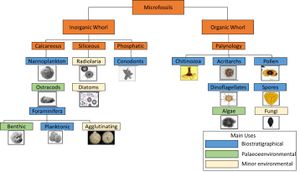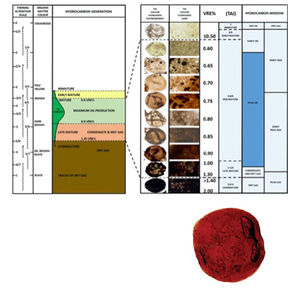Biostratigraphic applications in hydrocarbon exploration
| Wiki Write-Off Entry | |
|---|---|

| |
| Author | Sultan Alghufaily, Ali Alwaheed, and Ali Halal |
| Affiliation | Saudi Aramco |
| Competition | 2021 Middle East Wiki Write Off |
Biostratigraphy is the study of the temporal and spatial distribution of fossil organisms throughout the geological time scale. This science is based on the concept of evolution and extinction (Figure 1) of species at specific times where the process is not repeatable. The most important fossils for biostratigraphy are known as index fossils, which are abundant, widely distributed, easy to recognize, and occur only during a narrow time span. Preservation of fossils vary significantly, an entire organism or just a part of it. This is dependent on the nature of the fossilized organism, mechanism of preservation, and diagenesis of the rock unit. Fossils can be subdivided based on their size in three main groups: macrofossils (large enough to be visible without a microscope), microfossils (between 0.001mm and 1 mm in size) (figure 2) and nannofossils (between 5–60 μm in size). Biostratigraphy is used to identify rock formations which can occur at outcrop and/or in the subsurface and correlate time-equivalent units over large distances irrespective of lithology that can be variable due to change in environment and basinal configuration. Biostratigraphy plays an important role in petroleum exploration and production as it allows a number of cost-effective, quick and logistically simple ways to determine the ages of sedimentation, reservoir characterization, correlation and well site operation where field specific bioevents are determined and tested for consistency. Other applications include determining palaeoenvironment, paleobathymetry, assessing thermal maturity and highlight the possibility of having self-generating source rock strata.
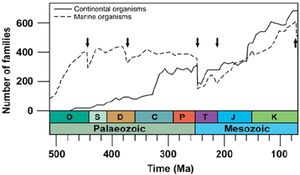
Factors Controlling the Abundance of Fossils[edit]
Throughout the geological record, fossils are an indirect proxy of the environment (paleo-indicators). In the presence of a continuous record, they can provide a good history due to their sensitivity as they can only tolerate a minor range in environmental parameters. Recent scientific researchers have found a distinct correlation between faunal abundance and diversity in correlation with environmental parameters in both dip and strike depositional line. Theses parameters include: water depth, temperature, salinity, oxygen supply, nutrient availability, availability of light, proximity to land and topographic variation. Therefore, the change in these environmental parameters will have a direct impact upon diversity and abundance of fossils which then can be used to build the environmental history.
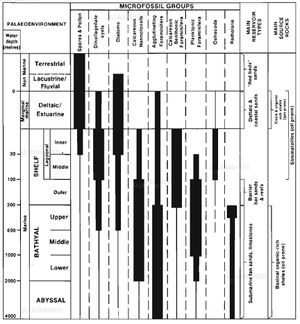
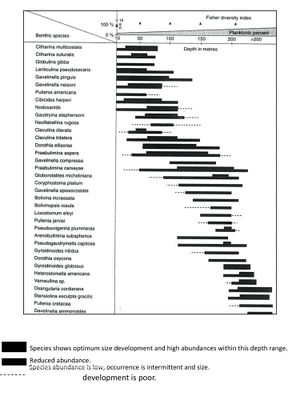
Applications[edit]
Given that fossils have limited stratigraphic range and their abundance and diversity is very sensitive to change in environmental parameters, different interpretations can be inferred from the fossils record. The use of biostratigraphy can be vital once integrated with different geological applications and basin modeling. The following are most common use of biostratigraphy in the oil industry:
- Age: the early and widely use application of biostratigraphy is the relative age dating. This biostratigraphic dating based on interception, overlap and/ or absence of the different index fossils. These index fossils have a short and non-repeatable life span. In operational use, dating is done through first downhole occurrence (FDO), while the last downhole occurrence (LDO) can be inaccurate due to mechanical caving.
- Identifying unconformity and structures: the application of biostratigraphic technique is widely used in the oil and gas industry for the reconstruction of the subsurface geology. Identifying missing and repeated sections both in the outcrop and subsurface, is possible by the use of biostratigraphy. Hiatuses and missing sections are identified via the absence of one or more biozones (assuming the absence is not due poor sampling and/ or sample processing). Detailed sampling will allow determining the time duration of the hiatuses and missing section. Unconformity identification is critical in hydrocarbon exploration, importance is highlighted in the stratigraphic trap evaluation (reservoir pinch out onto or beneath an unconformity surface will provide a trapping mechanism where overlying sediments provide a viable seal).
- Sequence stratigraphy: in integration with seismic and well logs data, biostratigraphy is an integral part in correlating similar and/or different lithofacies which are chronostratigraphically equivalent. The use is not only restricted to correlating packages, but also in identifying change in sea level and the associated surfaces and systems tracts, as discussed below.
- Sequence Boundary: is an important chronostratigraphic surface which marks a relative fall in sea-level. The magnitude of sea level fall may be variable, ranging from high to low. In case of dramatic sea level fall, biostratigraphy can resolve the hiatus and the erosional period via the juxtaposition of younger fossil assemblage on older ones (this will also usually indicate a sudden shift in palaeoenvironment). However, the ability of biostratigraphy in resolving the smaller magnitude in sea level fall may be limited and challenging. Despite being challenging, the fossils assemblage and composition across the boundary will vary across the depositional dip.
- Lowstand Systems Tract: marks a relative fall in sea level and is characterized by a basinward shift in facies. A non-marine – shallow marine deposits will overlay deeper marine facies. Biostratigraphic record will show an abrupt change in biostratigraphic assemblages and biofacies from marine to non-marine/ shallow marine. In palynology for example, higher pollen to dinoflagellates ratio maybe recorded.
- Transgressive Systems Tract: marks a relative increase in sea level; overall deepening and basinward shit upwards. In a complete and vertical succession, biofacies will mark the change from terrestrial to shallow marine and finally to deeper marine assemblages.
- Maximum Flooding Surface: marks the maximum marine engorging (from an overall deepening). In biostratigraphy record, this often condensed section will have the greatest potential of being dated and correlated across the basin. Mainly, due to diverse and abundant fossil record, especially planktonic foraminifera and deep water benthonic.
- Paleoenvironment: palaeoenvironmental interpretations based on biostratigraphy is possible because different organisms live in different habitats (Figure 2). Plants and animals occur in wide environmental habitats that range from terrestrial to deep marine, their ecological dependent on e.g. temperature, salinity, oxygen levels and water depth. Individual organism types have known environmental ranges, e.g. calcareous nannofossils are restricted to the marine settings (outer shelf to bathyal), while dinoflagellates range from marginal to bathyal marine environments. In palynology for example, ratio between dinoflagellates and pollen is important, not only to characterize the depositional environment but also to define the influence of fresh water upon the sediments, the higher pollen ratio the more continental influence. Defining the palaeoenvironment is important in the hydrocarbon exploration to characterize and predict the facies distribution. For example, from the paleoenvironment the geometry of the reservoir-body as well as the continuity and quality is inferred. In carbonate reservoirs defining the positon within the carbonate model, e.g. fore-reef or back-reef is critical which can be inferred from micro and nannofossils assemblages. In sandstone reservoirs studying the ratio between dinoflaellates and pollen is important to understand the marine verses the continental influence upon the reservoir continuity and quality.
- Paleobathymetry: Micro and macro-fossils are accounted as a good paleobathymetry indicators given their wide geological and basinal distribution. Benthic foraminifera for example are widely used in the industry to infer the paleobathymetry, given their sensitivity to oxygen percentage, presence of nutrition, salinity levels, and different adaptation to a certain water depth (Figure 4). Planktonic foraminifera on the other hand, normally used as a palaeoenvironment indicator i.e. open marine conditions but lacks water depth indicator due to their wider range of water depth adaptation (float on the sea, unlike the benthic found on the sea beds) (Figure 3). Ratios between different foraminiferal assemblage is also commonly used in the industry for example, ratio of planktonic to benthic and pollen to dinoflagellates. The higher the dinoflagellates the more marine conditions and vice versa.
- Operational: the use of wellsite biostratigraphy in integration with lithological description, log correlation and seismic interpretations is greatly used in the drilling operations. It enhances decision making including: planning the well paths, setting casing point, determining overpressure zone and calling for total depth. In setting casing points for example, assigning the age is critical to confirm the stratigraphic position. This is achieved via the use of bioevents based on First Downhole Occurrence (FDO) and Last Downhole Occurrence (LDO) calibrated to their age limit. Increasing the number of footage drilled within a reservoir body in a horizontally drilled wells can be improved via the use of biostratigraphy. This is based on characterizing the fossils content above and below the reservoir body. If the recorded fossil assemblage refers to a stratigraphic position above the reservoir then the driller will be instructed to drill stratigraphically downwards.
- Source rock potential and thermal maturity: palynology is commonly used in quantifying and assessing the characteristics and the thermal maturity of the source rock. Palynofacies refers to the description of the total kerogen content of palynological residues, including identification of individual palynomorph, plant debris, and amorphous components, their absolute and relative proportions, size spectra, and preservation states.[5] Palynofacies analysis is a powerful tool used to study the origin of and relationship between organic particles, and their potential for hydrocarbon generation in source rocks.. Generally, the structured terrestrially-derived organic debris of land-plant derivation is associated with gas generation, while the predominance of amorphous organic matter and structured algal palynomorphs are associated with oil-prone kerogen. Palynology, in integration with other disciplines also can help to assess the thermal maturity of organic-rich sediments (Figure 5). Several studies have demonstrated a direct relationship between increasing thermal maturity of organic rich sediments and irreversible color changes in palynomorphs and organic matter. Several thermal alteration indexes and visual charts have been proposed which relate palynomorph color to thermal maturity (e.g., Staplin,[6] Pearson,[7] and Hartkopf-Fröder et al.[8]). These are particularly useful in pre-Devonian sediments where Vitrinite Reflectance techniques cannot be used (Figure 5).
See also[edit]
References[edit]
- ↑ Cascales-Miñana, B., Diez, J.B., Gerrienne, P. and Cleal, C.J., 2016. A palaeobotanical perspective on the great end-Permian biotic crisis, Hist. Biol., 28, 1066–1074.
- ↑ Jenkins, J.M. ed., 2013. Applied micropalaeontology (p. 115). Springer Science & Business Media.
- ↑ Jones, R.W., 1996. Micropalaeontology in petroleum exploration (p. 173). Oxford: Clarendon Press.
- ↑ Ertug, K., Vecoli, M. and İnan, S., 2019. Palynofacies, paleoenvironment and thermal maturity of early Silurian shales in Saudi Arabia (Qusaiba Member of Qalibah Formation) (p. 12). Review of Palaeobotany and Palynology, Saudi Aramco, Dhahran, Saudi Arabia.
- ↑ Combaz, A., 1964. Les palynofaciès. Rev. Micropaleontol. 7, 205–218.
- ↑ Staplin, F.L., 1969. Sedimentary organic matter, organic metamorphism, and oil and gas occurrence. Can. Petrol. Geol. Bull. 17 (1), 47–66.
- ↑ Pearson, D.L., 1984. Pollen/Spore Color “Standard” Version 2. Phillips Petroleum Co., Geology Branch, Batlesville, Oklahoma.
- ↑ Hartkopf-Fröder C., Königshof, P., Littke, R., Schwarzbauer, J., 2015. Optical thermal maturity parameters and organic geochemical alteration at low grade diagenesis to anchi metamorphism: a review. Int. J. Coal Geol. 150-151, 74–119.
